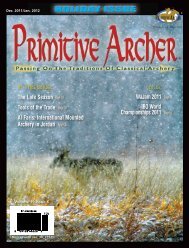In This Issue: plus: - Primitive Archer Online
In This Issue: plus: - Primitive Archer Online
In This Issue: plus: - Primitive Archer Online
You also want an ePaper? Increase the reach of your titles
YUMPU automatically turns print PDFs into web optimized ePapers that Google loves.
over forty downed cows. As he rode back to<br />
identify his kills, family members rushed<br />
down to retrieve his arrows and women and<br />
girls with butchering knifes exhalted their<br />
“Li-Li-li-li-leeee” vocal trills of excitement.<br />
Iron Bear’s three sons retrieved 15 of his 18<br />
arrows, and he put them back in his quiver.<br />
The arrows were marked with dark blue<br />
paint mixed with hide glue. Some were lost<br />
over the years, but they were a treasure kept<br />
by the family even when they settled onto the<br />
agency after returning from Canada in 1881.<br />
Iron Bear passed and in the 1920s a man<br />
from the Eya s’ic’a Oyate (German/Swiss<br />
people) came. It was during the depression<br />
when there was no work, especially on the<br />
remote and isolated Cheyenne River Sioux<br />
reservation. Crops were failing and times were<br />
hard. The man from Europe was looking for<br />
bows, arrows, moccasins, shirts, bonnets and<br />
other artifacts. He had $5 to offer for a set of<br />
arrows. That would buy a month’s worth of<br />
groceries for the family of eight—Iron Bear’s<br />
descendants. The man purchased the arrows<br />
along with clothing and beadwork and left the<br />
next day never to be heard from again.<br />
<strong>In</strong> April of 2012, I had the privilege to<br />
go to Switzerland and to stay with a very<br />
special family whom I am proud to call<br />
friends, the Gassmans. I taught Plains<br />
Horse <strong>Archer</strong>y for the first time in Europe<br />
to 17 students over a two-week period.<br />
Jack and Sam Gassman, brothers, helped<br />
wrangle horses and give ground technique<br />
instruction to students. We used Spanish<br />
Mustangs only (from the Windcross<br />
Conservancy Herd) for the clinic; they<br />
40<br />
www.<strong>Primitive</strong><strong>Archer</strong>.com Volume 21 <strong>Issue</strong> 1<br />
Bow and arrows<br />
made by the author.<br />
were the original horse brought to the<br />
Americas from Europe.<br />
During my stay in the small village of<br />
Buhler, my friends took me to one of the<br />
places I had wanted to visit, the Museum<br />
of St. Gallen. It was a marvelous house of<br />
treasures. During the 1920s, collecting<br />
American <strong>In</strong>dian artifacts was quite the<br />
rage in European countries like Germany<br />
and Switzerland. The oldest and quite<br />
possibly best examples of Native American<br />
artifacts can be found in museums in<br />
Europe, due to the fact that for 400 years<br />
prior to the 1920s, Europeans had been<br />
bringing back material items of every kind<br />
from the New World.<br />
Buyers would be given a bankroll and<br />
Author working with a young<br />
Spanish Mustang in South<br />
Dakota. Photo by Pam Keeley<br />
sent to the United States to go around to<br />
reservations and buy items for museum<br />
collections. Sometimes, of course, that<br />
included bows, arrows, and archery tackle.<br />
Many of these items were postagency/reservation<br />
era. These are items<br />
made specifically in the late 1890s or early<br />
1900s. However, a few older treasures<br />
seem to have wound up in the mix.<br />
Most of the buyers weren’t searching for<br />
specific items as much as they were on a<br />
trip for <strong>In</strong>dian “stuff.” However, I’m sure<br />
weapons and clothing were high on the list.<br />
My friends' son had done volunteer<br />
work at the museum, through him and the<br />
family's connections in St. Gallen, an<br />
appointment was set up for me to view the<br />
collection. <strong>This</strong> allowed me the opportunity<br />
to help identify some of the items and give<br />
Chokecherry shaft, purple chert, flared nock arrow<br />
used by the author to down a 2,000-pound bison in<br />
Cheyenne River with a 16-inch penetration.



